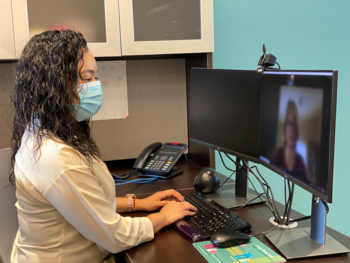In This Story
A new study from Health Administration and Policy Professor Alison Cuellar shows cost savings to insurance companies for telehealth visits because many people substitute virtual visits for in-person visits.

Telehealth has expanded rapidly since the COVID-19 pandemic. Though patients generally find virtual visits beneficial, policymakers and health insurers have been concerned that telehealth visits could raise health care costs if patients supplement in-person visits with telehealth, rather than substitute them. This concern has prevented some health insurers from expanding telehealth coverage that could support more patients.
A new study from George Mason University Health Administration and Policy Professor Alison Cuellar helps alleviate that fear. The study found that many people use telehealth as a substitute for in-person visits. The payment rates to the telehealth provider were lower than the average in-office visit, which further increased cost savings for the health insurer. Researchers studied the insurance claims from people with the three most common conditions (respiratory infections, diseases of the urinary system, and eye disorders) who used telehealth from a “direct-to-patient” telehealth provider.

“Private insurers and public programs are eager for research to show if telehealth offers a cost-effective alternative to in-person visits,” said Cuellar. “These findings can help inform how we think about telehealth coverage, both at federal and state levels. These patients benefitted from convenient tele-access to providers. More studies like this can help inform how patients choose their visits in a post-pandemic world.”
The study, “Outpatient Care Among Users and Nonusers of Direct-to-Patient Telehealth: Observational Study" was published in Journal of Medical Internet Research in June 2022.
Telehealth has improved access to health care by removing some barriers to in-person visits, such as transportation, unpaid time off, and childcare. Many health insurers created temporary telehealth policies during the height of the pandemic. However, these companies worry that telehealth visits in addition to in-person visits will cost the company more. The results of this study provide companies with data to support that virtual visits for three common conditions did not encourage more overall doctor’s visits and actually costs less overall.
The study, supported by the Agency for Heathcare Research and Quality, used 2017 private insurance claims for adults 18-64. The research team analyzed virtual visits, office-based primary care, urgent or retail clinics, and emergency departments based on claim codes. Virtual visit costs to insurers were the lowest among all the settings. Researchers acknowledge that the findings are limited by the parameters of the search, and findings may not apply to all forms of telehealth medicine.
##
